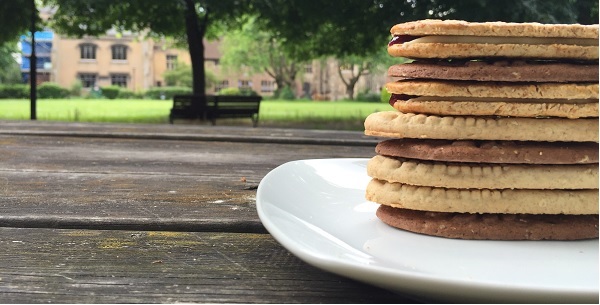New BMJ Open Study Reveals Wide Variation in Sugar and Calories in Cakes and Biscuits, as Industry is Accused of Not Complying
** Under embargo until 00.01 hours, Thursday 26 July 2018**

A NEW study by Action on Sugar at Queen Mary University of London, published by the journal BMJ Open,1 has investigated and documented the wide variation of sugar and calorie content within the same category of cakes and biscuits sold in the UK in 2016. The shock findings highlight 97% of cakes and 74% of biscuits received a ‘red’ (high) label for sugar (>22.5 g/100g). Despite this, the study showed that reformulation can be achieved.
Click here to view the full report
Click here to view media coverage
Furthermore, worrying data from the recently published report by Public Health England shows many cake and biscuit manufacturers are failing to reformulate and reduce the amount of sugar sold in their products. For example, Tesco increased sugar sold on average in their biscuits by 2.6%, Fox’s Biscuits (1.3% increase), Pladis UK/McVities (1.3% increase) and Mondelez (1.0% increase) – all failing to meet the 5% sugar reduction target. In cake, Tesco (4.0% increase) and Sainsbury’s (0.6% increase) also increased the amount of sugar sold through cakes instead of meeting the 5% reduction target.2
In contrast, some companies made substantial reductions in the amount of sugar sold through cakes, exceeding the 5% target including Asda (-22.9% decrease) and Waitrose (-27.0% decrease). While, General Mills (-8.8%), the Co-operative (-8.0%) and Asda (-5.2%) reduced sugar sold through biscuits.
Cakes
In the BMJ Open paper, the average sugar content in cakes was 36.6g/100g coupled with a large variation in sugar content between different categories of cakes. On average, Battenberg (56.4g/100g) contained the highest amounts of sugar, followed by Genoa (45.9g/100 g) and red velvet cakes (44.2g/100g), while blueberry muffins (24.6g/100g) contained the lowest amount of sugar. More importantly there was a large variation within the same category of cake e.g. among Victoria sponge or similar cakes, ranging from 23.4 to 59.2g/100g. This variation demonstrates that reformulation can easily be done i.e. if some manufacturers can produce a similar cake with far less sugar or calories so can others. In the per serving analysis, consumers can find a Victoria sponge with as little as 11.9g sugar compared with a slice containing 34.3g sugar – a difference of 6 tsp.
Similar to sugar, there was also a large variation in energy/calorie content between different categories of cakes. On average, plain sponge with chocolate (446 kcal/100g) contained the highest amount of energy, while Genoa cakes (356 kcal/100g) contained the lowest amount of energy. Again, there were large variations within the same category of cakes e.g. chocolate Swiss rolls, ranging from 366 to 500 kcal/100g.
Branded cakes had a slightly higher sugar content per 100g compared with supermarket own label (37.7g vs 36.3g). Among the manufacturers with five or more cakes, the McVitie's product range contained the highest average sugar (43.1g) and Premier Foods contained the highest energy (424 kcal) per 100g.
Biscuits
The average sugar content in biscuits was 30.0g/100g as well as a large variation in sugar content between different categories of biscuits. On average, iced biscuits (43.5g/100 g) contained the highest amounts of sugar and shortbread biscuits (17.5g/100 g) contained the lowest. More importantly there was a large variation in sugar content within the same category of biscuits, e.g. among breakfast biscuits, ranging from 12.0 to 30.9g/100g.
The average energy content in biscuits was 484 kcal/100g. Shortbread biscuits with additions (528 kcal/100 g) contained the highest amount of energy and fruit-filled biscuits (391 kcal/100 g) contained the lowest amount. Similarly, there was a large variation in energy content in similar biscuit products, e.g. among jam and cream biscuits, calorie content ranged from 425 to 558kcal/100g.
Among the manufacturers with five or more products, the Fox’s product range contained the highest average sugar content, 35.8 g/100 g, and Dr. Schar product range contained the highest average energy content, 512 kcal/100 g.
Our study has shown that reductions in sugar and energy/calorie content of cakes and biscuits are possible since there was a large variation in sugar and energy content between different cake and biscuit categories and within the same category. A reduction in sugar and energy content, and overall cake and biscuit consumption, can help reduce overall sugar and energy intake in the UK and thus reduce the risk of obesity and tooth decay.
In 2016, the government’s sugar-reduction programme was launched, where food and drink companies were asked to reduce sugar in their products by 20% by 2020.3Manufacturers can choose to achieve the 20% reduction in a number of ways: by reformulating their products (without increasing overall calories), reducing portion size or promoting their lower-sugar products.
Kawther Hashem, co-author of the study and registered Nutritionist, for Action on Sugar at Queen Mary University of London says: “This research clearly shows the levels of sugar and calories in products can be reduced since there was a large variation in sugar and calorie content within the same category of cakes and biscuits yet worryingly not all manufacturers are complying. If some manufacturers can produce chocolate cake bars with 22% fewer calories per 100 g, so can others.”
Graham MacGregor, co-author of the study and Professor of Cardiovascular Medicine at Barts and The London School of Medicine and Dentistry and Chairman of Action on Sugar says: “Large amounts of cakes and biscuits are consumed in the UK so a reduction in the amount of sugar and calorie content could play an important role in helping prevent obesity and tooth decay. The majority of the food and drink industry in the UK have asked the government for a more robust and mandatory programme of reformulation.4It is a tragedy for our children that this has not been done.”
Katherine Hale, World Cancer Research Fund’s Head of Health Information, says: “The difference in levels of sugar in very similar foods that this study has revealed is shocking, but it does show that if one manufacturer can reduce sugar levels in their products, then it is possible for other manufacturers to do the same. We now need the government to take stronger action and make it compulsory for food manufacturers and retailers to reduce sugar levels in their products. Eating too much sugar leads to overweight and obesity, which our latest cancer prevention report shows is a cause of 12 different types of cancer. Healthy lifestyle patterns depend not only on individual choices but also on governments creating an environment that encourages people to eat healthily and do more exercise. WCRF calls on the government to prioritise cancer prevention through the development and implementation of effective policies to address the rising burden of obesity and cancer in the UK.”
Martyn Gray, Managing Director of Nairn's says: "We know that biscuits are something of an institution – Mintel report that biscuits are eaten by 9 out of 10 people in the UK. At Nairn’s we recognise that it’s ok to treat yourself every now and then and we make it even easier for people to make that treat something that is healthier but doesn’t compromise on taste. We use less sugar in our award winning oat biscuit ranges than other biscuit brands. We also compare them against over 100 other ‘similar’ products to get a comparative average. Depending on the flavour, our biscuits contain between 30-45% less sugar than the average of those other biscuits”.
For more information contact: David Clarke @ Rock PR:
M: 07773 225516
References
1. Hashem KM, He FJ, Alderton SA, et al. Crosssectional survey of the amount of sugar and energy in cakes and biscuits on sale in the UK for the evaluation of the sugar-reduction programme. BMJ Open 2018. http://doi.org/10.1136/ bmjopen-2017-01907
2. Public Health England. Sugar reduction: report on first year progress https://www.gov.uk/government/publications/sugar-reduction-report-on-first-year-progress
3. Public Health England. Sugar Reduction: Achieving the 20% A technical report outlining progress to date, guidelines for industry, 2015 baseline levels in key foods and next steps https://assets.publishing.service.gov.uk/government/uploads/system/uploads/attachment_data/file/604336/Sugar_reduction_achieving_the_20_.pdf
4. The Guardian. Childhood obesity: retailers urge mandatory cuts to food sugar levels. https://www.theguardian.com/society/2016/aug/18/childhood-obesity-retailers-urge-mandatory-cuts-to-food-sugar-levels


